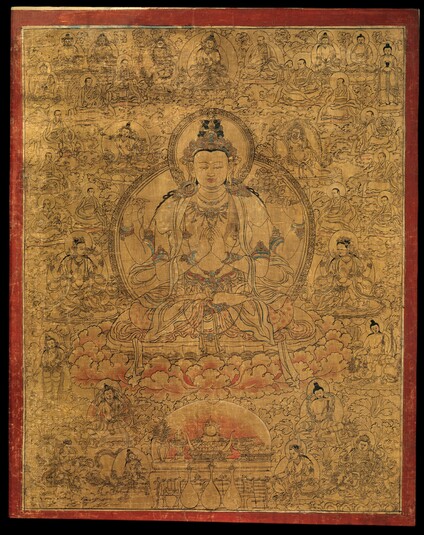
Item: Avalokiteshvara (Bodhisattva & Buddhist Deity) - Chaturbhuja (4 hands)
| Origin Location | Tibet |
|---|---|
| Date Range | 1500 - 1599 |
| Lineages | Sakya and Buddhist |
| Material | Ground Mineral Pigment, Gold Background on Cotton |
| Collection | The Metropolitan Museum of Art |
Alternate Names: Lokeshvara Avalokita Lokanata Lokanatha Mahakarunika
Classification: Deity
Appearance: Peaceful
Gender: Male
Avalokiteshvara, Chaturbhuja (Tibetan: chen re zi, chag shi pa. English: the All Seeing Lord with 4 Hands. Date: circa 1530).
Video: Lokeshvara & the Tsembupa Tradition
This painting is a rare composition depicting the teaching lineage tradition of the Tsembupa Martri of the Sakya School of Tibetan Buddhism. The Martri is a teaching focussed on the special Tantric methods of practice associated with Avalokiteshvara, in whatever manifestation a practitioner is comfortable with. The teaching is named after the first Tibetan teacher, Tsembupa Darma Wozer (13th century), who received the instructions directly from Vajrayogini (sometimes Nairatmya) in a vision.
There are two other paintings identified as belonging to the same set as this Avalokiteshvara. Formerly of the Jucker collection and now in the Rubin Museum of Art collection (RMA) is the painting of Sakya Tridzin Jambai Dorje. Again, from the former Halpert collection and now in the RMA collection is the painting of Hevajra. Each of these paintings have a gold background and similarity in brush stroke and line. Their size is identical and the inscriptions on the back of the Jambai Dorje and Hevajra paintings are identical. The back of the Avalokiteshvara is yet to be revealed.
The central figure is Avalokiteshvara with four hands. At his right is the male attendant Manidharin and at the left, the female, Shadakshari. Both are similar to the Lord in colour, ornaments and appearance. Sometimes they are referred to as the son and daughter of Avalokiteshvara.
"As the nature of all buddhas, Avalokiteshvara, in colour like stainless conch and crystal, very resplendent, smiling, peaceful and radiant. With four hands the first are folded at the heart, the lower hold a crystal mala and jewelled lotus, two beautiful feet seated in vajra posture, adorned with many attractive silks and jewels, beautified with dark blue hair in tufts [some] loose. On the crown of the head, the wisdom of all buddhas, is the Lord, source of all refuge gathered as one, in essence the Guru in the aspect of Amitabha, in the manner of the Lord of the Family, seated happily." (Ngorchen Konchog Lhundrub 1497-1557).
Avalokiteshvara is the patron bodhisattva of Tibet and is included in all Buddhist traditions. There are numerous New (Sarma) lineages and varying forms of practice that span all four tantric classifications as well as uncounted old oral traditions (Kama) and Treasure (Terma) traditions from the Nyingmapa School.
There are many different sacred Buddhist traditions that depict the various forms of Avalokiteshvara. Most of these traditions only have an initiation ritual and at best a very short daily ritual practice. Preserved in the Tibetan Buddhist tradition there are seven principal traditions that contain extensive teachings on the practice of Avalokiteshvara. The first of these is the [1] King's Tradition (gyal lug) of Tri Songtsen Gampo, [2] Bhikshuni Shri Tradition (gelongma palmo lug) of the Kashmiri nun, Gelongma Palmo [top right corner], [3] Kyergangpa Tradition (gyergang lug) of the Shangpa Kagyu School, [4] Tsembupa Tradition (tsembupa lug) of the Sakyas, [5] Dagyal Tradition (dagyal lug) of the Nyingma Treasure (terma) tradition, [6] Maitri Yogin and [7] the Karma Chagme Tradition (karma chagme lug) joining the philosophical systems of mahamudra and dzogchen with compassion.
Jeff Watt 2-2007
Numbered Schematic: 1. Chaturbhuja Avalokiteshvara 2. Manidharin 3. Shadakshari 4. Manjushri 5. Vajrapani 6. Vajradhara 7. Vajrayogini 8. Akshobhya 9. Amitayus 10. Amitabha 11. Maha Vairochana 12. Amitabha 13. Medicine Buddha 14. Avalokiteshvara (Standing) 15. Simhanada 16. Khasarpani 17. Chitta Vishramana 18. White Jambhala 19. Vaishravana Riding a Lion 20. Yellow Vasudhara 21. Yellow Jambhala
Lineage Teachers: 1. Vajradhara 2. Vajrayogini 3. Tsembupa 4. Jangchub Od 5. Jangchub Tsultrim 6. Sonam Nyingpo 7. Tugje Tsondru 8. Gyalwa Yeshe 9. Zhonnu Sengge 10. Sonam Gyaltsen Pal 11. Tegchen Choje 12. Palden Legpa 13. Dagchen Dorje Chang 14. Doringpa 15. Tsarchen Losal Gyatso (1502 – 1566)
Avalokiteshvara Forms: 1. Chaturbhuja (Four Arms) 2. (Standing) 3. Simhanada (Lion's Roar) 4. Khasarpani Lotus Holder 5. Chitta Vishramana (Resting the Mind) 6. White Jambhala (an emanation of Avalokiteshvara)
Figures number one to four are forms of Avalokiteshvara himself. Figure number 6 is White Jambhala Riding a Dragon, an emanation of Avalokiteshvara. White Jambhala functions as a Wealth Deity. Coloured Groupings:
Yellow: Three Lord of the World 1. Avalokiteshvara 2. Manjushri 3. Vajrapani
Green: Avalokiteshvara, Son & Daughter 1. Avalokiteshvara (yellow coloured section) 2. Manidharin 3. Shadakshari Bottom: Offerings
Blue (top & bottom): Deities
Red (top): Lineage Teachers
Red (bottom): Wealth Deities - White Jambhala, Vaishravana Riding a Lion, Yellow Vasudhara & Yellow Jambhala.
Front of Painting
English Translation of Inscription: [Name inscriptions for each of the lineage teachers].
Reverse of Painting
English Translation of Inscription: [Currently there is no information about the back of the painting].
Buddhist Deity: Avalokiteshvara ('Mar Tri ' Description & Bibliography)
Thematic Sets
Buddhist Deity: Avalokiteshvara, Four Hands (Masterworks)
Painting Type: Gold Ground Masterworks
Buddhist Deity: Avalokiteshvara, Chaturbhuja (Three Deity)
Painting Tradition: Menri
Painting Traditions Page
Buddhist Deity: Avalokiteshvara, Four Hands (Painting Masterworks)
Subject: Tsembupa Martri
Painting Sets: Teaching Lineages
Buddhist Deity: Avalokiteshvara, Chaturbhuja Iconography
Buddhist Deity: Avalokiteshvara Religious Context
Buddhist Deity: Avalokiteshvara Masterworks (Painting)
Painting Type: Gold Ground
Buddhist Deity: Avalokiteshvara Main Page
Buddhist Deity: Avalokiteshvara, Chaturbhuja (Early Works)
Painting Set: Sakya Gold Ground (Series)
Collection of The Metropolitan Museum of Art: Main Page
Buddhist Deity: Avalokiteshvara, Chaturbhuja - Four Hands - Main Page
Buddhist Deity: Avalokiteshvara Lineage Paintings













